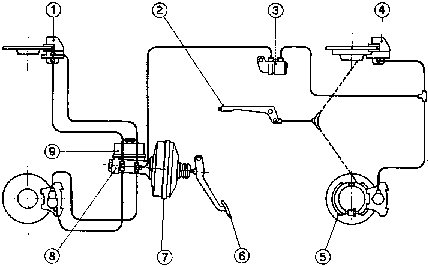 |
||||||||||
|
||||||||||
| Main Index of Fulvia Q & A | CD's with Fulvia documentation | Fulvia homepage | viva-lancia.com homepage | ||||||||||

|
Below is a drawing and text, copied from the "Fulvia models - Concise repair shop manual" about the Superduplex brake system.
Superduplex Brake Circuits. By depressing the brake pedal (6), pressure is exerted on a stem, which passing through the servo unit (7) operates the master cylinder (8). The servo unit boosts such pressure and reduces the load to be applied by the driver to brake the car. The master cylinder (8) consists of two tandem arranged plungers, each one controlling an independent circuit. The two circuits of the master cylinder (8) allow braking the car also when one of them has failed. The brake fluid controlled by the master cylinder (8) actuates the caliper plungers (1-4) with displace the friction pads against the brake discs to brake the car. Eeach front caliper friction pad is controlled by two plungers, having different diameters, whilst each rear caliper friction pad is operated through one plunger only. The front caliper bigger plungers are controlled through the master cylinder front circuit. The master cylinder rear circuit actuates both the front caliper smaller plungers (1) and the rear caliper plungers (4) and is called the mixed circuit. In case of trouble to the front circutt, the braking is ensured on all the four wheels, as the mixed circuit controls both the front and rear friction pads. In case of failure to the mixed circuit, fair braking action is ensured to the front wheels, owing to the bigger plungers. The mixed circuit line to the rear calipers is fitted with the balance limiter (3) which sets the fluid pressure acting on the rear brakes according to the load bearing on the axle, in order to prevent locking to the rear wheels and skidding. |
|||||
| Top of page | Main Index of Fulvia Q & A | CD's with Fulvia documentation | Fulvia homepage | viva-lancia.com homepage | ||||||
|
||||||
